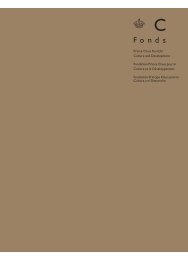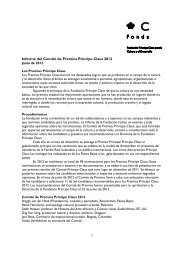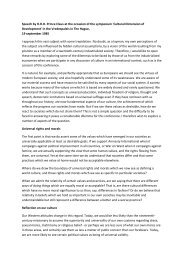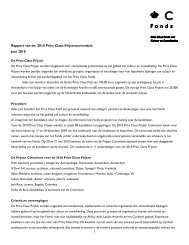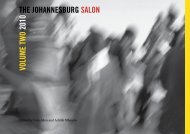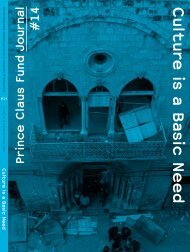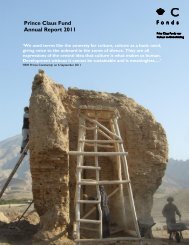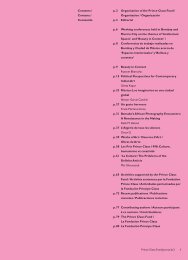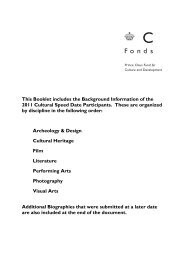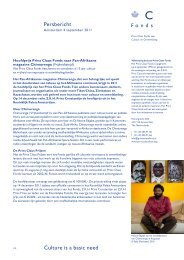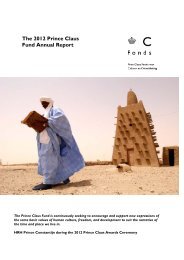3 summer 2011 - Prince Claus Fund
3 summer 2011 - Prince Claus Fund
3 summer 2011 - Prince Claus Fund
- No tags were found...
Create successful ePaper yourself
Turn your PDF publications into a flip-book with our unique Google optimized e-Paper software.
030–053talattekin_alt:turklergaram 29.11.2007 9:21 Uhr Seite 421. In Kumuk, the initial palatal /k/ changes to /g/: käç-> geç-, ke:çä > geçe “evening,” käl- > gel-, kertü > gerti “true,right,” ke:t- > get- “to go,” ke:tär- > geter- “to remove,” kötür-> götür- “to lift,” kişi > gişi, etc.2. In Kumuk, vowel rounding takes place in severalwords as a result of following labial consonants: ağzımız >awzubuz, awçı > awçu “hunter,” bağımız > bawubuz, kamış >kamuş, birlän > bulan “with,” yapış- > yabuş-, etc.3. The initial postvelar /q/ changes to guttural fricative/x/: qonşı > xonşu “neighbor,” kum > xum “sand,” qu:rt > xurt“wolf,” etc.4. The initial /ä/ is narrowed to /i/: ädär- > iyer- “to follow,”äg- > iy-, “to bend,” ädlä- > iyle- “to wet,” ärü- > iri- “tomelt,” etc.5. The /r/ sound at the end of the plural suffix disappearsbefore the genetive-accusative suffix -nı/-ni and thedative suffix -ga/-ge: giççiler “little ones,” but giççile-ni “littleones’,” ullular “adults,” but ullula-nı “adults’,” balalar “children,”but balala-ğa “to the children,” üyler “houses,” but üyle-ge “tothe houses,” etc.6. A vowel is created at the end of words of Arabic originthat end in a pair of consonants alien to the Turkic language:Arabic asl > aslu “basic, main,” Ar. fikr > fikru “idea,” Ar.ilm > ilmu “science,” Ar. waqt > wakti “time”; but Ar. sabr >sabur “patience,” etc.A few sentences in Kumuk: Awrumaygan başnı yawlıkbulan baylamas “They do not treat anyone who isn’t ill”; İssiliğolay güçlü çü, hatta adam suwdan çıkmağa süymey “It is so hotthat nobody wants to come out of the water”; Yer Günnüaylanasından aylana “The earth goes around the sun”; Onuki tüzbolmak neden görüne dağı? “How is it obvious that he is right?”Cıyın tünegün boldu “The meeting was held yesterday”; Sütteawzu bişgen suwuk suwnu üfürüp içer “He who scalds his mouthwith hot milk will blow on cold water before drinking.”G. The Karachay-Balkars and Their LanguageThe Karachays and Balkars (or Malkars) are two Turkishpeoples with very similar dialects. The Karachays live mainly inthe Autonomous Karachay-Circassian province linked to theRussian Federation, while the Balkars (or Malkars) live in theAutonomous Kabardin-Balkar Republic. There are also smallKarachay and Balkar communities in Kirghizstan, Kazakhstan,and Uzbekistan. According to the 1989 census, the total numberof Karachays and Balkars in the former Soviet Unionamounted to 156,140 and 88,771, respectively. There are alsosmall Karachay communities in Turkey.Written forms of Karachay and Balkar emerged followingthe Soviet revolution. From 1920 to 1924, the Karachays andBalkars employed an Arabic alphabet, and from 1924 to 1936they used a Latin alphabet. Since 1936, they have employed aCyrillic alphabet.The Karachay-Balkar dialects can be divided into threegroups: (1) The Karachay-Baksan-Chegem dialect, (2) theMalkar (Balkar) dialect, (3) the Holaml›-B›z›ng›l› dialect.The Karachay written language is based on theKarachay-Baksan-Chegem dialect. The characteristic featuresof the Karachay-Balkar written language are common to theKipchak group of languages: the change of the initial /a€/ into42LANGUAGE AND IDENTITY/aw/ (bağ > baw “vineyard,” tağ > taw “mountain,” etc.); thechange of the final /a€u/ into /ow/ (buzağu > buzow “calf,”kırağu > kırow “frost,” etc.); the change of the final /ägü/ into/ew/ (bilägü > bilew “grindstone,” küdägü > küyew “groom,”etc.); and the change of /o€, u€, ow/ into /uw/ (boğ- > buw-,tuğ- > tuw- “to be born,” kow- > kuw- “to repel,” soğık > suwuk“cold,” etc.).1. As for the distinguishing features of Karachay-Balkar,the most important is the disappearance of the /r/ at the endof the plural suffix: tağlar > tawla “mountains,” yigitler > cigitle“youths.” The final /r/ at the end of the copula -dır/-dir disappears:aman “bad,” aman-dı “(it is) bad,” aşxı “good,” aşxı-dı “(itis) good,” etc.2. Another feature of Karachay-Balkar is the use of thesuffix -lık/-lik, -rık/-rik in forming the future tense: bar-lık-ma “Iwill go,” min-nik-me “I will ride,” aşa-rık-sa “You will eat,” etc.3. One of the most important features of Karachay-Balkar is the change of /aw, awu/ to /uw/ or /uwu/: aw > uw“hunt,” awçı > uwçu “hunter,” awuç > uwuç “palm,” etc.Similarly, /ög, üg/ change to /üy/ or /ü/: ögrän- > üren-, ögrät-> üret-, ügür > üyür “family,” tügüm > tüyüm “knot,” etc.A few sentences in Karachay-Balkar: Ahmat elge deribardı “Ahmet went to the village”; Sabiyle tamadalarını aytxanlarınatınggılay edile “The children listened to what their elderswere telling them”; Ol kanatlını uçup barganlay atadı “He hits thebird in flight”; Men kesimi cangılganımı angılayma “I realize Imade a mistake”; Anı caşawu alkın allındadı “He has his wholelife in front of him.”H. The Karaim and Their LanguageThe Karays, or Karaim (Karaim is the plural of the Hebrewword Karay, employed in the Torah to refer to “a reader of theHoly Book”), are members of an Old Turkic community whowere converted to Judaism during the Khazar period.Until quite recently, the Karaim lived as small communitiesin Lithuania in the cities of Trakai (Troki) and Panevé_ys,and in Ukraine in the cities of Lutsk and Halicz (Halich). In formertimes, there were also Karaim communities near the cityof Evpatoria on the Crimean Peninsula. According to the 1959census, the total number of Karaim living in the former SovietUnion was 5,900; by the time of the 1989 census, the numberhad fallen to 2,803. Before 1930, the Karaim employed theHebrew, Latin, and Cyrillic alphabets in writing their language,but most of the old manuscripts of religious texts (translations)are, naturally, in the Hebrew script.Karay, which is now a dead language, had three dialects:(1) Troki (Trakai), (2) Halich-Lutsk, and (3) Crimean. TheCrimean dialect of Karay was once assimilated by CrimeanTatar. The Troki and Halich-Lutsk dialects are now totally assimilatedby the Slav languages. There are several important differencesbetween the Troki and Halich dialects of Karay:1. Although in the Halich dialect the back explosive /k/is generally preserved, in the Troki dialect it changes to fricative/x/: Halich arık = Troki arıx “tired,” H aksak = T axsax, Hkasık = T kaşux “spoon,” H yabuk = T yabux “closed,” H yırak =T yırax “far,” etc.2. Similarly, although /c/ is preserved in the Trokidialect, in the Halich dialect it changes to affricate /dz/: T canYenisei inscriptions,sixth century. MinusinskMuseum, Minusinsk,Russia.<strong>Prince</strong> <strong>Claus</strong> <strong>Fund</strong> Reader #1 · Summer <strong>2011</strong> · 52



